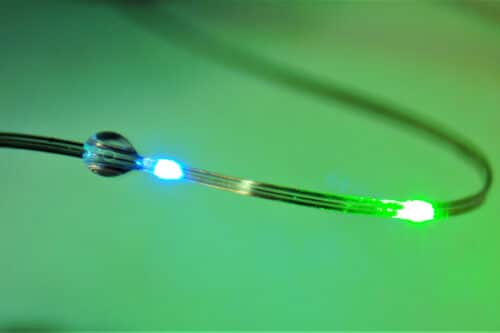MIT engineers have developed a groundbreaking technology for exploring neural circuits responsible for regulating hunger, mood, and various diseases.

Image: Courtesy of the researchers
The brain and the digestive system maintain continuous communication, transmitting signals that regulate feeding and various behaviours. This intricate communication network also impacts our mental well-being and has been associated with numerous neurological disorders.
Researchers at MIT have developed a novel technology employing sensor-embedded fibres and optogenetic stimulation to manipulate neural circuits connecting the gut and the brain in mice. The researchers induced fullness or reward-seeking behaviour in mice by manipulating intestinal cells, aiming to investigate the connections between digestive health and neurological conditions like autism and Parkinson’s disease in future studies.
The brain-body connection
The researchers developed a flexible electronic interface composed of thin polymer filaments, created using thermal drawing, which can be embedded with electrodes, temperature sensors, microscale light-emitting devices for optogenetic stimulation, and microfluidic channels for drug delivery. These fibres possess customizable mechanical properties suitable for various body parts, such as stiffer fibres for deep brain insertion and delicate yet durable rubbery fibres for digestive organs, ensuring compatibility without harming the organ lining despite the challenging digestive environment. In addition, the fibres are engineered to enable wireless control, allowing an external control circuit to be temporarily attached to the animal during experiments.
Driving behaviour
Using the interface, researchers manipulated the gut and brain to influence behaviour. They stimulated dopamine release in the brain’s ventral tegmental area (VTA), causing mice to seek a specific chamber for the dopamine reward. Additionally, they induced the same reward-seeking behaviour without sucrose by releasing sucrose in the gut or stimulating gut nerve endings connected to the vagus nerve. The researchers tested the fibres’ control over feeding behaviours. They found that optogenetic stimulation of cholecystokinin-producing cells suppressed appetite in fasted animals, and similarly, stimulating cells that produce PYY curbed appetite after consuming rich foods.
The researchers intend to employ the interface to investigate neurological disorders associated with the gut-brain connection. For instance, they aim to explore the higher prevalence of GI dysfunction in autistic children and the shared genetic risks between anxiety and irritable bowel syndrome.






